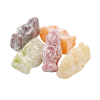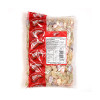 *Delivery prices can vary for Highlands & Islands of Scotland, Northern Ireland and British Isles.
*Delivery prices can vary for Highlands & Islands of Scotland, Northern Ireland and British Isles.Please see delivery details page for more information.
Jelly Babies: The Plump, Sugared Sweet with a Surprisingly Chewy Past
It begins, as all great British traditions do, with an unlikely origin and a dose of marketing whimsy. The humble Jelly Baby, that cherubic, sugar-dusted, gelatinous lump of joy, didn’t so much burst onto the scene as it quietly waddled its way into the nation’s affections—plump, oddly anthropomorphic, and far tastier than its name suggests. But behind the soft shell and vibrant colours lies a story of war, peace, branding, and a cultural staying power that not even a Time Lord could resist.
The Sweet Beginnings – Lancashire’s First Jelly Baby
Let’s rewind to the 1860s in Lancashire, where an enterprising confectioner at Fryers of Lancashire allegedly created the first ever “Jelly Baby”. Legend has it that the product was the result of a happy accident, originally intended to be shaped like bears. The resulting sweets were, instead, rotund and vaguely humanoid—hence, Jelly Babies. They remained a niche treat until Bassetts of Sheffield (yes, the very same Bassetts behind the iconic liquorice allsorts) revived the concept in 1918, branding them as “Peace Babies” to celebrate the end of the First World War.
They were a hit—not least because the British public, fresh from rations and sorrow, needed something soft, colourful, and unapologetically sweet. “Peace Babies” marched forth triumphantly until the Second World War scuppered production due to rationing. But Bassetts, undeterred, brought them back with a new name in 1953: Jelly Babies.
Each One with a Name and a Personality
If you thought Jelly Babies were simply blobs of gelatin with sugar dusting, you’re underestimating the eccentricity of British confectionery marketing. Each Jelly Baby was given a name and personality by Bassetts in the 1980s, as part of a rebranding effort. There was Bubbles (pink, always in love), Brilliant (red, a genius), Baby Bonny (purple, shy), Boofuls (green, easily startled), Bigheart (yellow, kind), and Bumper (orange, sporty). Yes, really. They had personalities before many 80s sitcom characters did.
Doctor Who and the Cultural Zeitgeist
No account of Jelly Babies would be complete without mentioning their role in British television lore. The Fourth Doctor—Tom Baker’s wonderfully unhinged, scarf-swathed incarnation of Doctor Who—famously offered Jelly Babies to aliens and villains alike, often prefacing danger with: “Would you like a Jelly Baby?” Thus, these sweets achieved pop culture immortality as both a charming prop and an unlikely peace offering. They were, in the truest sense, bigger on the inside.
Beyond Bassetts: A Sweet That Multiplied
Though Bassetts (now owned by Maynards Bassetts under Mondelez International) may be the historic originator, the modern Jelly Baby landscape is a colourful marketplace of brands, variants, and dietary adaptations. Let’s take a closer look at the current crop of jelly-based contenders:
- Monmore’s Jelly Babies – Classic and straight to the point, this 140g bag captures the traditional flavour profile of soft, fruit-flavoured baby-shaped jellies with a nostalgic dusting of sugar. A go-to for fans of the authentic British sweet shop vibe.
- Barratt Jelly Babies – The 3kg box from Barratt brings big scale and even bigger memories. These are a staple in the wholesale world, ideal for pick n mix setups and party bags. Expect bold fruit flavours and soft, pliable texture.
- Haribo Jelly Babies – Yes, even Haribo, famed for its Goldbears, has entered the Jelly Baby fray. Their 100-count tub delivers the Haribo twist: slightly firmer chew, punchier flavour, and broad kid appeal. It’s the continental take on a British classic.
- Vimto Jelly Babies – A twist no one expected and everyone welcomed. Infused with the unmistakeable berry-and-grape blend of Vimto, this version is as fruity as a picnic in a hedgerow and just as satisfying.
- Candycrave Vegan Fizzy Blue Jelly Babies – A modern marvel. These bright blue, sour-coated Jelly Babies are 100% vegan, made without gelatine, and deliver a zesty bite that sets them apart. Think of them as Jelly Babies for the next generation: ethical, bold, and deliciously unconventional.
The Great Jelly Baby Debate
Ask anyone in Britain about Jelly Babies, and you’ll spark a debate. Some swear by the originals; others claim the newer fizzy or vegan versions are superior. The texture, the flavour, the coating—everyone has a preference. Even the colour order in which they’re eaten is a source of contention. Are the red ones best? (Yes.) Are the green ones underrated? (Also yes.) Should you bite off the head first? Well… perhaps it’s best we don’t ask.
More Than Just a Sweet – A Symbol of British Eccentricity
Jelly Babies represent something curiously British. A sweet that is at once silly and sentimental. There’s nothing quite like them in global confectionery. Gummy bears? Too stiff. Gummy worms? Lacking narrative. Jelly Babies have a story, a legacy, and—if you're old enough—a heavy dose of nostalgia.
They’re the edible equivalent of a cosy jumper, a cup of tea, or a Radio 4 comedy panel show—reassuring, timeless, and best enjoyed slowly. Except most people don’t. They pop three at a time and feel slightly guilty afterwards. That, too, is very British.
Where to Buy Jelly Babies Today
While you can still find Maynards Bassetts Jelly Babies in most major supermarkets, the wider world of Jelly Babies is thriving online. Retailers like Monmore Confectionery offer a full range—from the large-scale Barratt Jelly Babies perfect for parties, to vegan-friendly Candycrave Jelly Babies that bring fizz and ethics together in one adorable package.
Whether you're stocking up for retail, creating your own sweet jars, or simply feeding your inner child, there’s never been more choice—or more personality—in the world of Jelly Babies.
The Final Chew
In a world of fleeting trends and faddy snacks, the Jelly Baby endures. Its name is odd, its form stranger still, and yet its appeal is universal. From a confectionery accident in Victorian Lancashire to vegan, fizzy, blue reincarnations in bulk 2kg bags, the Jelly Baby is proof that when something is right—it sticks. Preferably to your teeth.
So go on. Have one. Maybe even two. Just be warned—they never travel alone.









